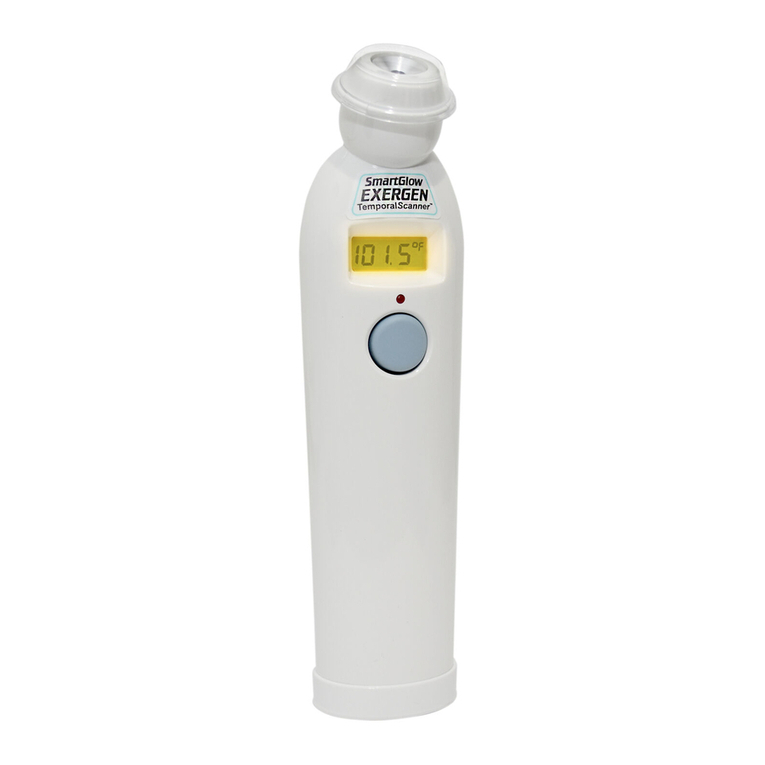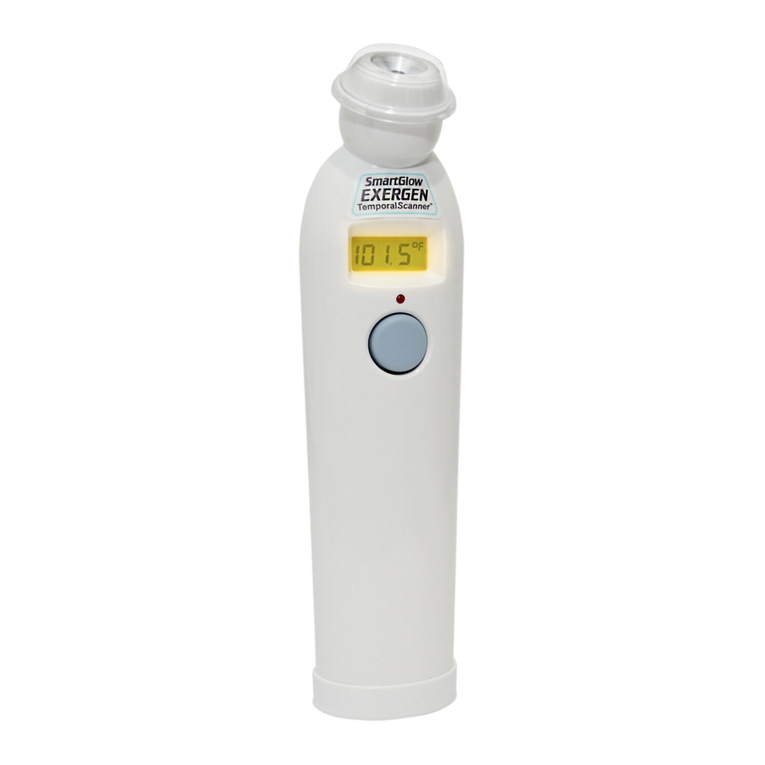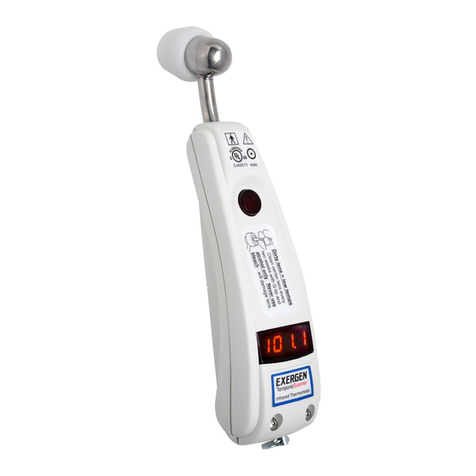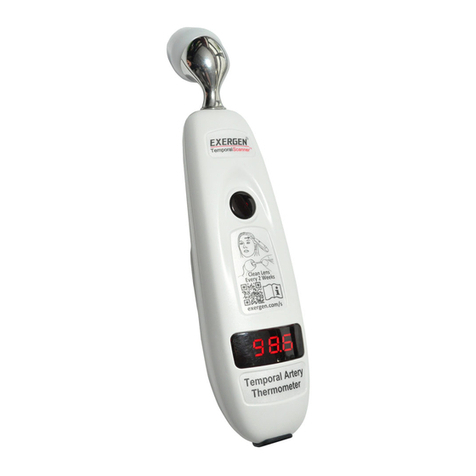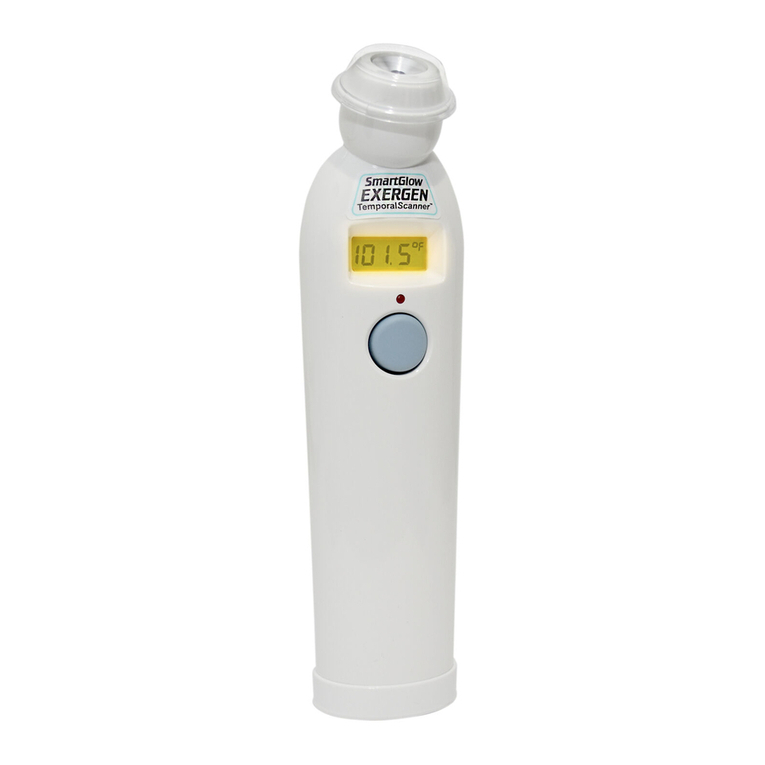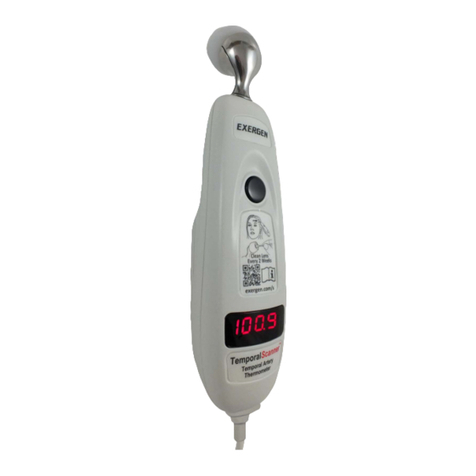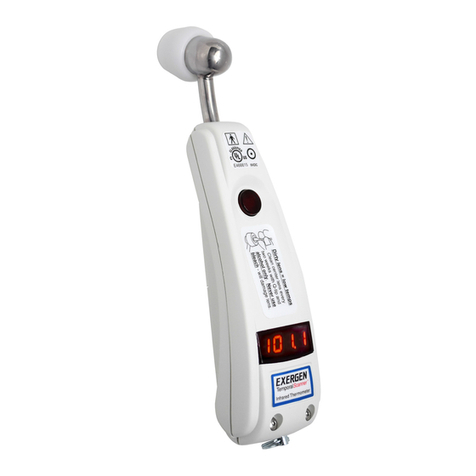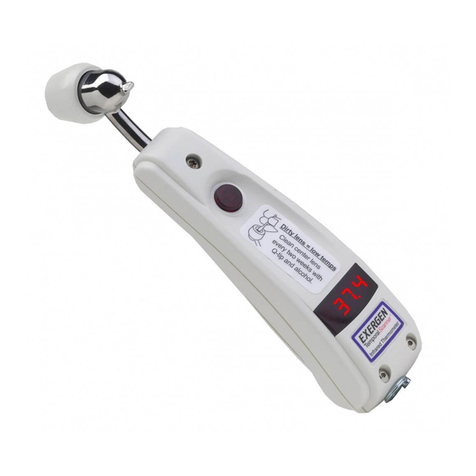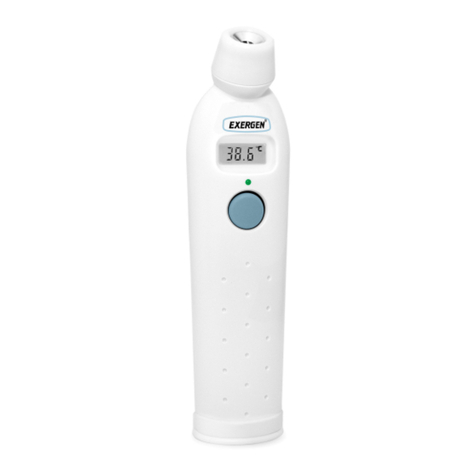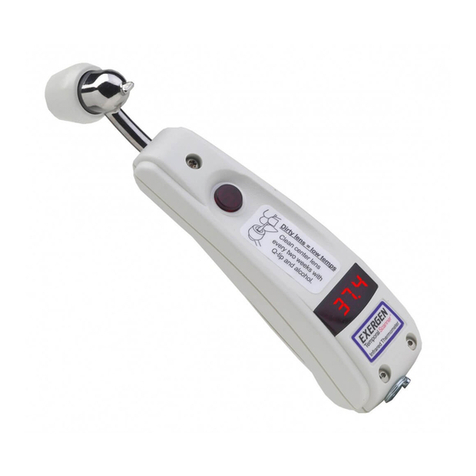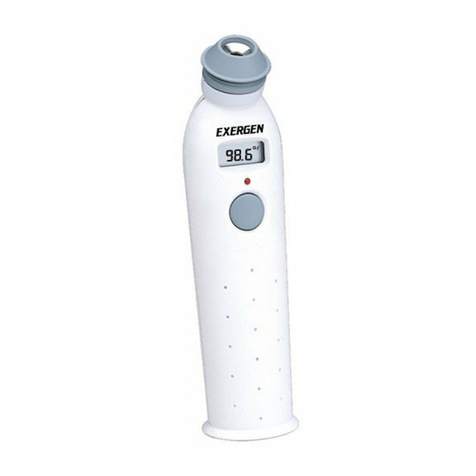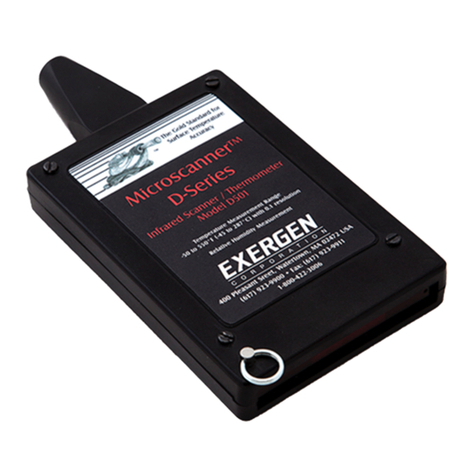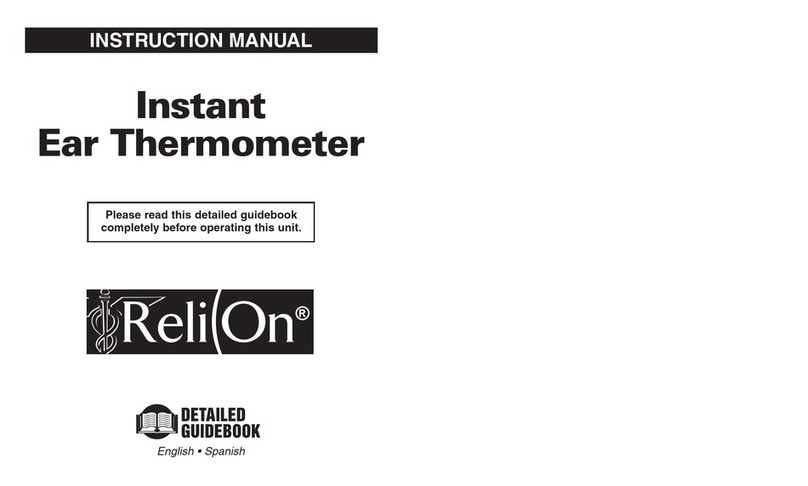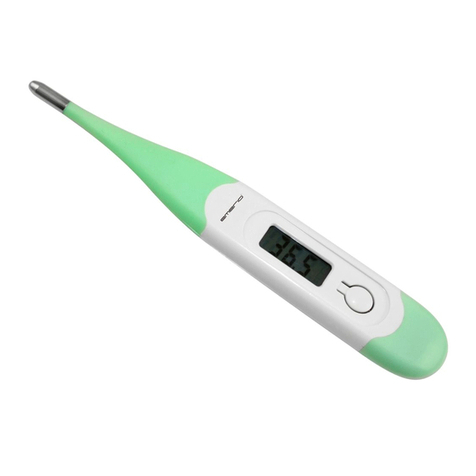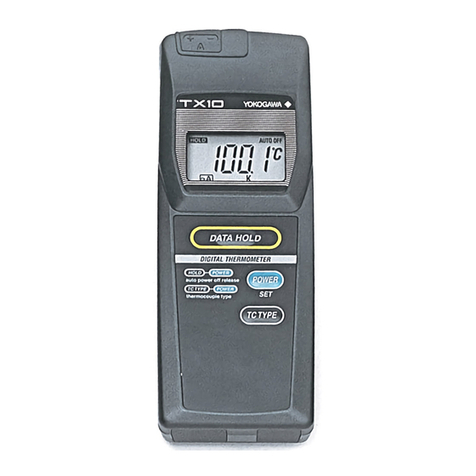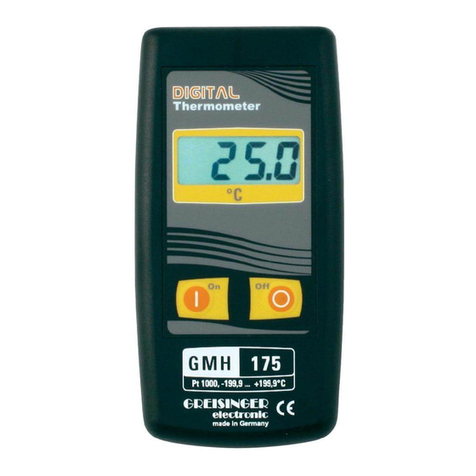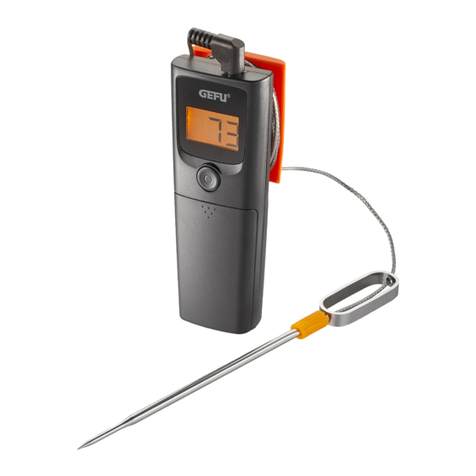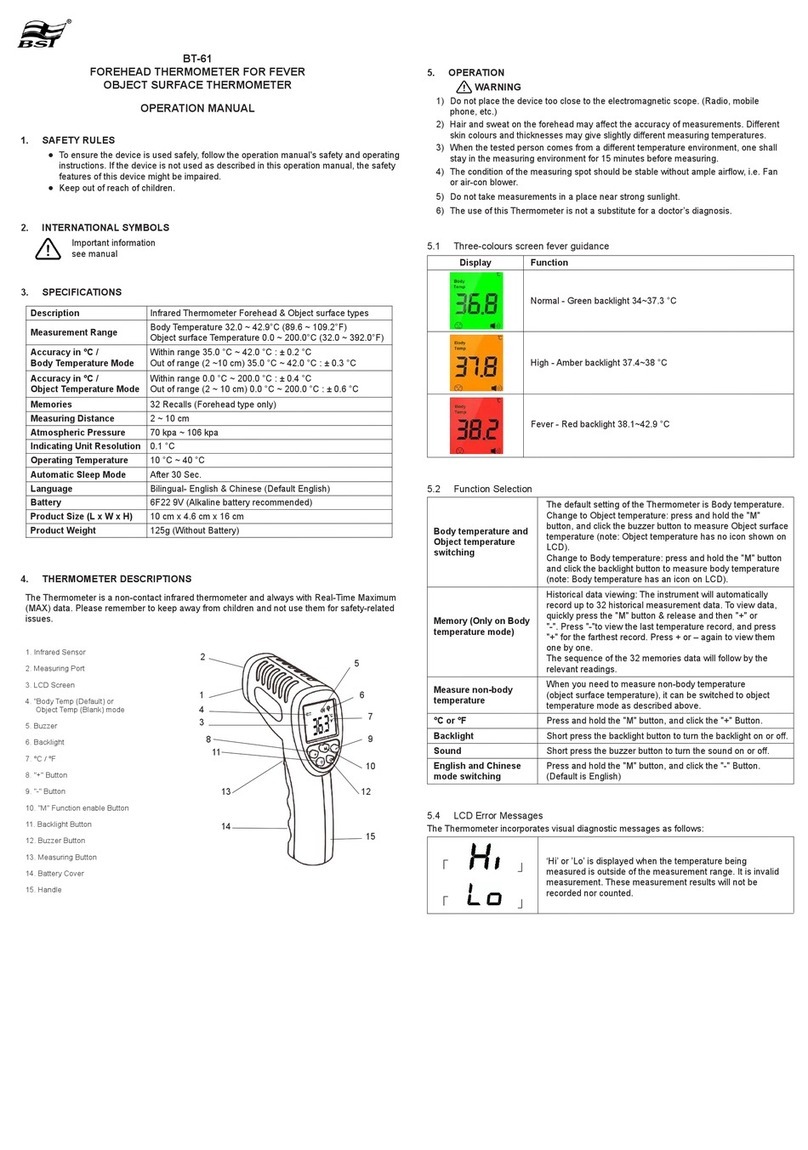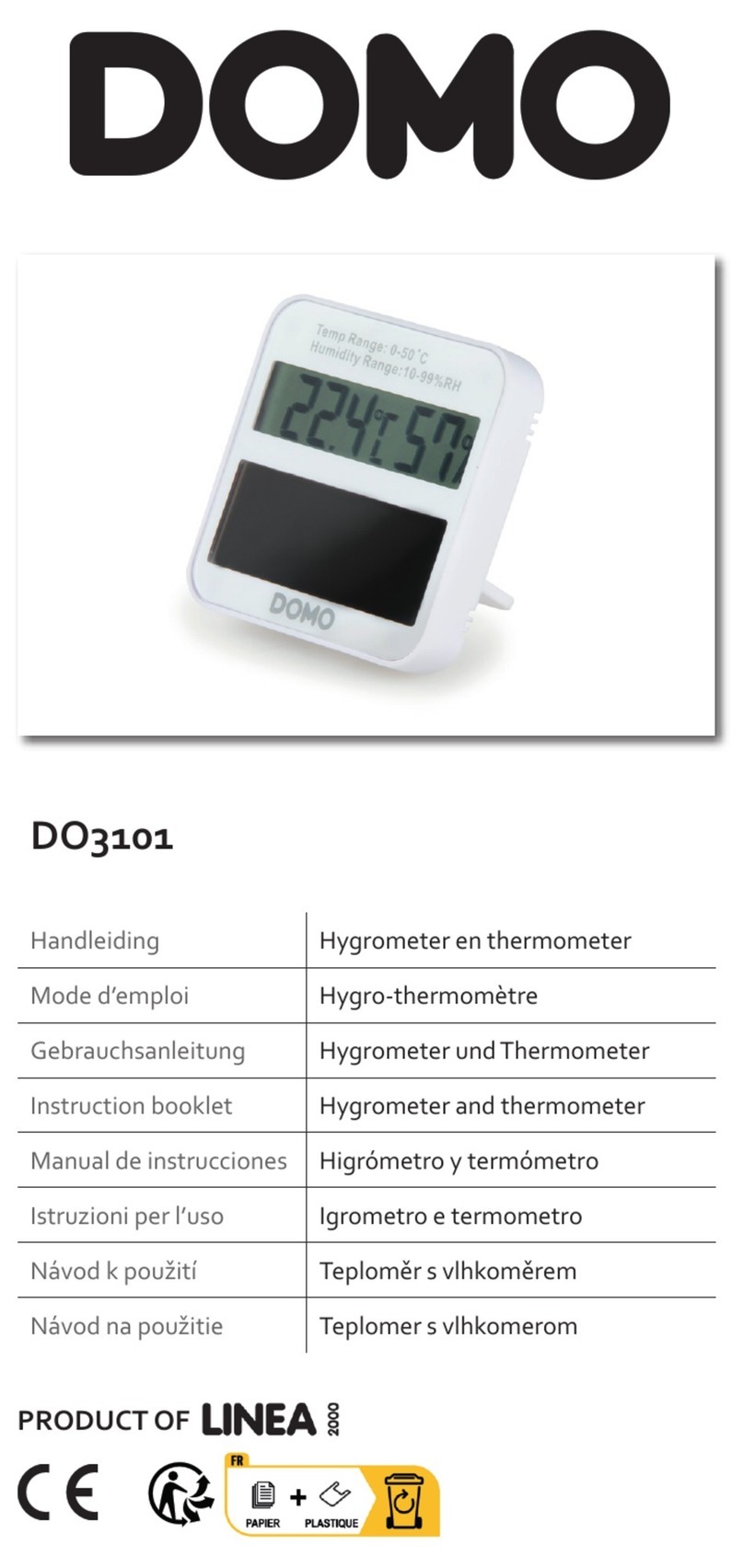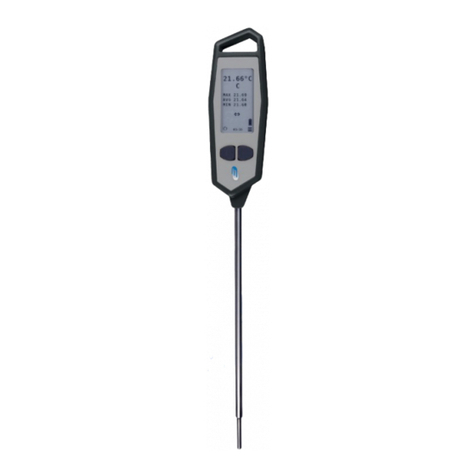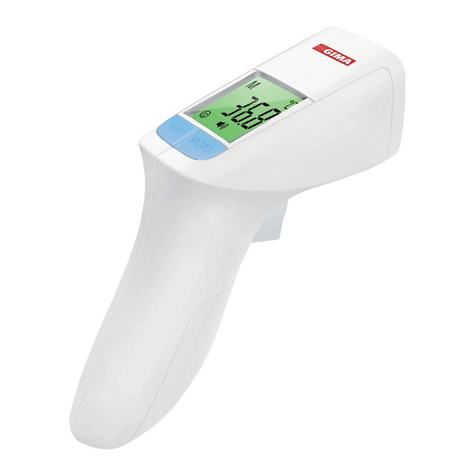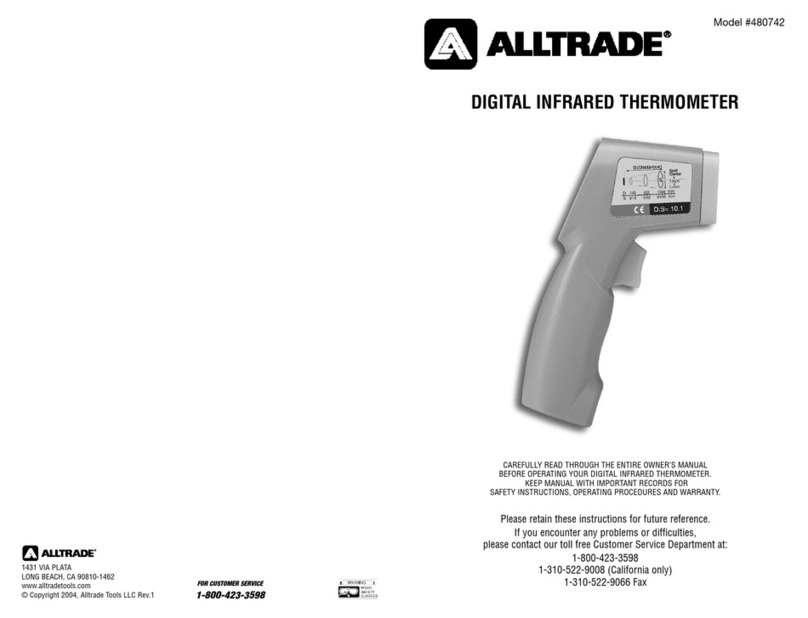What you should know before using the TAT:
• Measure only the side of the head exposed to the environment.
Anything covering the area to be measured (hair, hat, wig, ban-
dages) would insulate the area, resulting in falsely high read-
ings.
• Slide the thermometer straight across the forehead, not down
the side of the face. Midline on the forehead, the TA is about a
millimeter below the skin, whereas at the side of the face, the
TA is much deeper, and measuring there would result in falsely
low readings.
• When taking a temperature behind the ear lobe, first push away
any hair, exposing the area. Then, tuck the thermometer on
the neck under the ear lobe, in the soft conical depression be-
low the mastoid, (the place where perfume is typically applied).
• Wait about 30 seconds before measuring the same patient
again to avoid excessive cooling of the skin.
• An infant frequently presents with blankets and clothing cover-
ing the neck area. Since the perfusion rate is normally strong
for infants, and unless visibly diaphoretic, one measurement at
the TA area is typically all that is required. Should you feel the
temperature is low, then push aside any clothing or blankets
covering the neck area for ~30 seconds or so, and repeat the
measurement behind the ear.
Measuring TA Temperature
8
2. Fever Definition: Clinically, fever is defined as a BT
≥1.8°F (1°C) above the mean standard deviation at the
site of recording.2
A single oral temperature of ≥101°F (38.3°C ) in the ab-
sence of obvious environmental causes is usually consid-
ered fever. An oral temperature of ≥100.4°F (38.0°C )
over at least 1 hour indicates a fever state.3
A single arterial temperature >101.8°F (38.8°C) in the ab-
sence of obvious environmental causes is usually consid-
ered fever. An arterial temperature >101.2°F (38.4°C)
over at least 1 hour indicates a fever state.
While the above are recommended guidelines, not all fe-
vers require laboratory tests, and clinical assessment in
concert with standard hospital protocol for fever workups
should always prevail.
3. Oral Temperature Risks: Oral temperature can be clini-
cally misleading, and many febrile patients can have a
“normal” temperature.4 Mouth breathing, tachypnea,
heated gases, and hot or cold fluids can distort the read-
ing, as can intubation or inability of the patient to cooper-
ate. Accordingly, comparisons with TA may not be reli-
able.
Clinical Information
13
What you should know before using the TAT:
• Measure only the side of the head exposed to the environment.
Anything covering the area to be measured (hair, hat, wig, ban-
dages) would insulate the area, resulting in falsely high read-
ings.
• Slide the thermometer straight across the forehead, not down
the side of the face. Midline on the forehead, the TA is about a
millimeter below the skin, whereas at the side of the face, the
TA is much deeper, and measuring there would result in falsely
low readings.
• When taking a temperature behind the ear lobe, first push away
any hair, exposing the area. Then, tuck the thermometer on
the neck under the ear lobe, in the soft conical depression be-
low the mastoid, (the place where perfume is typically applied).
• Wait about 30 seconds before measuring the same patient
again to avoid excessive cooling of the skin.
• An infant frequently presents with blankets and clothing cover-
ing the neck area. Since the perfusion rate is normally strong
for infants, and unless visibly diaphoretic, one measurement at
the TA area is typically all that is required. Should you feel the
temperature is low, then push aside any clothing or blankets
covering the neck area for ~30 seconds or so, and repeat the
measurement behind the ear.
Measuring TA Temperature
8
2. Fever Definition: Clinically, fever is defined as a BT
≥1.8°F (1°C) above the mean standard deviation at the
site of recording.2
A single oral temperature of ≥101°F (38.3°C ) in the ab-
sence of obvious environmental causes is usually consid-
ered fever. An oral temperature of ≥100.4°F (38.0°C )
over at least 1 hour indicates a fever state.3
A single arterial temperature >101.8°F (38.8°C) in the ab-
sence of obvious environmental causes is usually consid-
ered fever. An arterial temperature >101.2°F (38.4°C)
over at least 1 hour indicates a fever state.
While the above are recommended guidelines, not all fe-
vers require laboratory tests, and clinical assessment in
concert with standard hospital protocol for fever workups
should always prevail.
3. Oral Temperature Risks: Oral temperature can be clini-
cally misleading, and many febrile patients can have a
“normal” temperature.4 Mouth breathing, tachypnea,
heated gases, and hot or cold fluids can distort the read-
ing, as can intubation or inability of the patient to cooper-
ate. Accordingly, comparisons with TA may not be reli-
able.
Clinical Information
13
What you should know before using the TAT:
• Measure only the side of the head exposed to the environment.
Anything covering the area to be measured (hair, hat, wig, ban-
dages) would insulate the area, resulting in falsely high read-
ings.
• Slide the thermometer straight across the forehead, not down
the side of the face. Midline on the forehead, the TA is about a
millimeter below the skin, whereas at the side of the face, the
TA is much deeper, and measuring there would result in falsely
low readings.
• When taking a temperature behind the ear lobe, first push away
any hair, exposing the area. Then, tuck the thermometer on
the neck under the ear lobe, in the soft conical depression be-
low the mastoid, (the place where perfume is typically applied).
• Wait about 30 seconds before measuring the same patient
again to avoid excessive cooling of the skin.
• An infant frequently presents with blankets and clothing cover-
ing the neck area. Since the perfusion rate is normally strong
for infants, and unless visibly diaphoretic, one measurement at
the TA area is typically all that is required. Should you feel the
temperature is low, then push aside any clothing or blankets
covering the neck area for ~30 seconds or so, and repeat the
measurement behind the ear.
Measuring TA Temperature
8
2. Fever Definition: Clinically, fever is defined as a BT
≥1.8°F (1°C) above the mean standard deviation at the
site of recording.2
A single oral temperature of ≥101°F (38.3°C ) in the ab-
sence of obvious environmental causes is usually consid-
ered fever. An oral temperature of ≥100.4°F (38.0°C )
over at least 1 hour indicates a fever state.3
A single arterial temperature >101.8°F (38.8°C) in the ab-
sence of obvious environmental causes is usually consid-
ered fever. An arterial temperature >101.2°F (38.4°C)
over at least 1 hour indicates a fever state.
While the above are recommended guidelines, not all fe-
vers require laboratory tests, and clinical assessment in
concert with standard hospital protocol for fever workups
should always prevail.
3. Oral Temperature Risks: Oral temperature can be clini-
cally misleading, and many febrile patients can have a
“normal” temperature.4 Mouth breathing, tachypnea,
heated gases, and hot or cold fluids can distort the read-
ing, as can intubation or inability of the patient to cooper-
ate. Accordingly, comparisons with TA may not be reli-
able.
Clinical Information
13
What you should know before using the TAT:
• Measure only the side of the head exposed to the environment.
Anything covering the area to be measured (hair, hat, wig, ban-
dages) would insulate the area, resulting in falsely high read-
ings.
• Slide the thermometer straight across the forehead, not down
the side of the face. Midline on the forehead, the TA is about a
millimeter below the skin, whereas at the side of the face, the
TA is much deeper, and measuring there would result in falsely
low readings.
• When taking a temperature behind the ear lobe, first push away
any hair, exposing the area. Then, tuck the thermometer on
the neck under the ear lobe, in the soft conical depression be-
low the mastoid, (the place where perfume is typically applied).
• Wait about 30 seconds before measuring the same patient
again to avoid excessive cooling of the skin.
• An infant frequently presents with blankets and clothing cover-
ing the neck area. Since the perfusion rate is normally strong
for infants, and unless visibly diaphoretic, one measurement at
the TA area is typically all that is required. Should you feel the
temperature is low, then push aside any clothing or blankets
covering the neck area for ~30 seconds or so, and repeat the
measurement behind the ear.
Measuring TA Temperature
8
2. Fever Definition: Clinically, fever is defined as a BT
≥1.8°F (1°C) above the mean standard deviation at the
site of recording.2
A single oral temperature of ≥101°F (38.3°C ) in the ab-
sence of obvious environmental causes is usually consid-
ered fever. An oral temperature of ≥100.4°F (38.0°C )
over at least 1 hour indicates a fever state.3
A single arterial temperature >101.8°F (38.8°C) in the ab-
sence of obvious environmental causes is usually consid-
ered fever. An arterial temperature >101.2°F (38.4°C)
over at least 1 hour indicates a fever state.
While the above are recommended guidelines, not all fe-
vers require laboratory tests, and clinical assessment in
concert with standard hospital protocol for fever workups
should always prevail.
3. Oral Temperature Risks: Oral temperature can be clini-
cally misleading, and many febrile patients can have a
“normal” temperature.4 Mouth breathing, tachypnea,
heated gases, and hot or cold fluids can distort the read-
ing, as can intubation or inability of the patient to cooper-
ate. Accordingly, comparisons with TA may not be reli-
able.
Clinical Information
13












